A bottle containing a green substance is placed close to the window at the third floor of the school. A red straw sticks out and sometimes someone gets close and blows to move the green particles that after a few minutes lay down on the bottom again. That was the first draft of the algae farm. We didn’t know they could really light up a LED. But it really happened. Our Introductory Studio research aims to capture the energy that otherwise would be lost during the metabolism process of the algae. This energy is green and it needs to be shown through a temporary and functional installation at Valldaura Self-Sufficient Lab, transmitting a message of change.
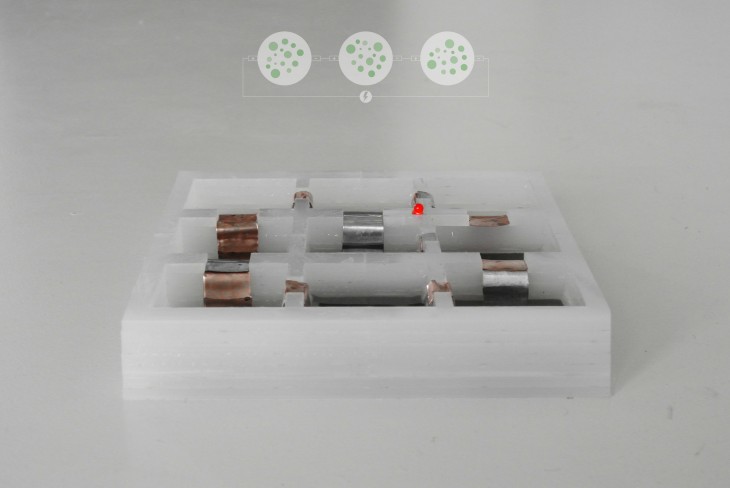 The research studio started with evaluating the capacity of algae to release energy during their life span. During the first two weeks, we managed to create a battery using two metal plates (zinc and copper) as anode and cathode. They are bended to touch the bottom part of the container where the algae settle, while the opposite edges are connected to a multimeter measuring the voltage and giving us the result of less than 1V. After a few days of right sunlight exposure, constant temperature and input of nutrients and carbon dioxide, the same container gave us a better and significant result. Setting more containers in a series connection and using the same quantity of algae+water we tripled the first electricity value succeding to light up a 3 volts LED. Fabricating a technical and compact prototype by laser-cutting allowed us to evaluate the number of cells we needed to turn on more LEDs by multiplying the number of the containers with our living energy source.
The research studio started with evaluating the capacity of algae to release energy during their life span. During the first two weeks, we managed to create a battery using two metal plates (zinc and copper) as anode and cathode. They are bended to touch the bottom part of the container where the algae settle, while the opposite edges are connected to a multimeter measuring the voltage and giving us the result of less than 1V. After a few days of right sunlight exposure, constant temperature and input of nutrients and carbon dioxide, the same container gave us a better and significant result. Setting more containers in a series connection and using the same quantity of algae+water we tripled the first electricity value succeding to light up a 3 volts LED. Fabricating a technical and compact prototype by laser-cutting allowed us to evaluate the number of cells we needed to turn on more LEDs by multiplying the number of the containers with our living energy source.
 The first draft has been improved in a farm for the reproduction of micro-algae, mostly Chlorella Vulgaris, and cyanobacteria that contribute to create the perfect environment for their growth. Several containers are equally filled with the green source and supplied with carbon dioxide via air lines connected to a general pump through some T connectors. It has been preferred to split the green matter into more containers to respond to the natural growth inhibition caused by the overcrowding. The air pushed into the water allows the movement of the particles and their breeding.
The first draft has been improved in a farm for the reproduction of micro-algae, mostly Chlorella Vulgaris, and cyanobacteria that contribute to create the perfect environment for their growth. Several containers are equally filled with the green source and supplied with carbon dioxide via air lines connected to a general pump through some T connectors. It has been preferred to split the green matter into more containers to respond to the natural growth inhibition caused by the overcrowding. The air pushed into the water allows the movement of the particles and their breeding.
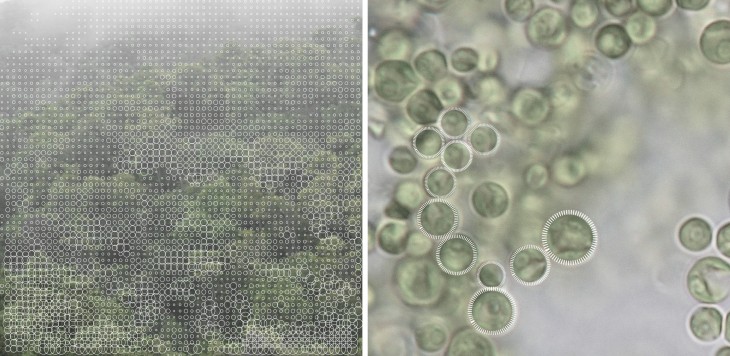 We have been focusing on a initial morphological proposal. As first design exercise, the patterns deduced from gradients and microscopical snap-shots, helped us figure out the disposition, composition and connection of the cellular matter. The modeling process defined the overall structure and the single biophotovoltaic cell.
We have been focusing on a initial morphological proposal. As first design exercise, the patterns deduced from gradients and microscopical snap-shots, helped us figure out the disposition, composition and connection of the cellular matter. The modeling process defined the overall structure and the single biophotovoltaic cell.
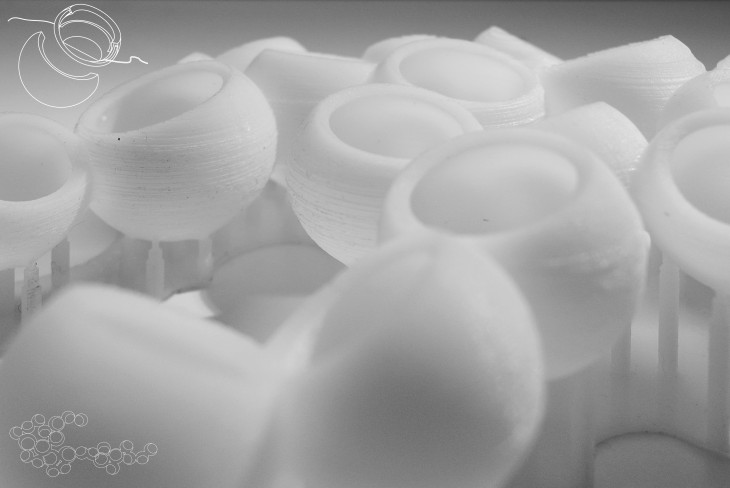 The cellular pattern is initially composed by three different modules that change for size, parametrically arranged in different ways to simulate motion and diversity. Looking at the way the Chlorella Vulgaris reproduces, the bigger module has been, in turn, divided in 9 sub-cells, while the smaller ones have been combined in pairs, each one with 4 cells electrically connected each other. This allowed to free the arrangement possibilities and give the cells complete autonomy.
The cellular pattern is initially composed by three different modules that change for size, parametrically arranged in different ways to simulate motion and diversity. Looking at the way the Chlorella Vulgaris reproduces, the bigger module has been, in turn, divided in 9 sub-cells, while the smaller ones have been combined in pairs, each one with 4 cells electrically connected each other. This allowed to free the arrangement possibilities and give the cells complete autonomy.
 The starting shape has been improved to integrate the cells with the pipes movement in the air. Pipes represent the necessary interaction between users and algae. The users are invited to blow in the airlines connected to each sub-cell to supply the algae with carbon dioxide and force the motion of the particles. The algae respond with light
The starting shape has been improved to integrate the cells with the pipes movement in the air. Pipes represent the necessary interaction between users and algae. The users are invited to blow in the airlines connected to each sub-cell to supply the algae with carbon dioxide and force the motion of the particles. The algae respond with light
 In order to be able to fabricate multiple components we had to merge simplicity with aesthetics. The discretisation of the organic cells arrived to a triangulated sphere with output for electricity and interaction through localized inward and outward extrusions.
In order to be able to fabricate multiple components we had to merge simplicity with aesthetics. The discretisation of the organic cells arrived to a triangulated sphere with output for electricity and interaction through localized inward and outward extrusions.
Form and function define one other. The installation will take place along the entrance pathway of Valldaura campus as witness of a change in the collective environmental awareness and as introducer to the Self-Sufficient lab. The elevation of the cells to an upper level permitts the mutual interaction and benefit between visitors, who are able to contribute to the algae sustenance by blowing into the pipes connected to each sub-cell, and algae that release oxygen and attest their presence through light.
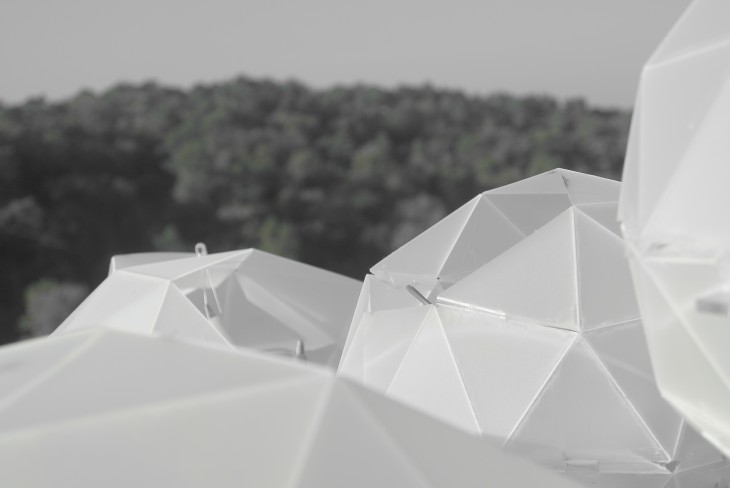

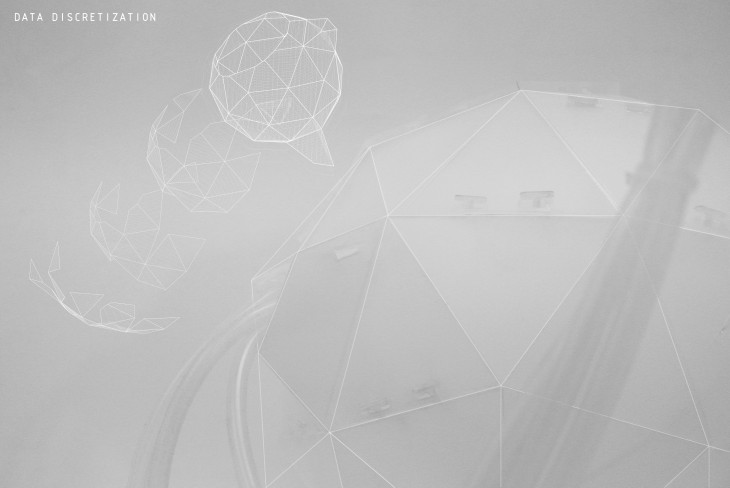
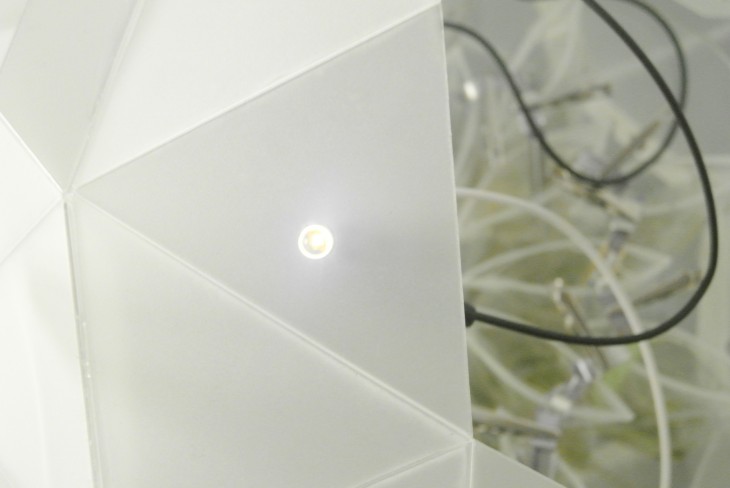
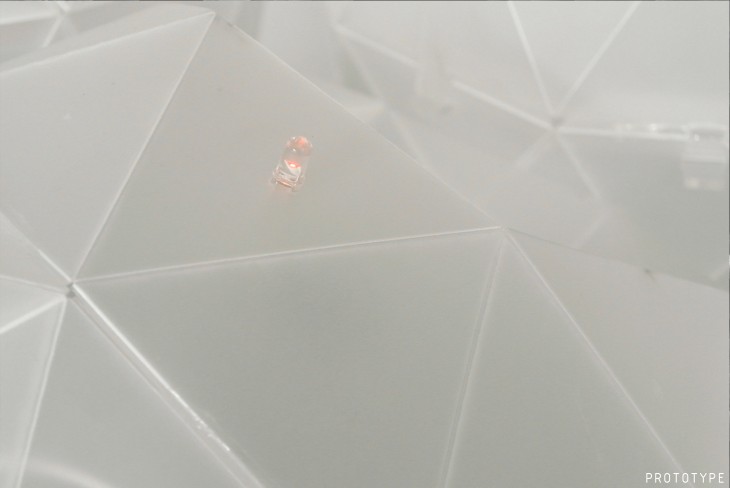
One Trackback
navigate here…
Wonderful Web page, Stick to the good job. Appreciate it!…